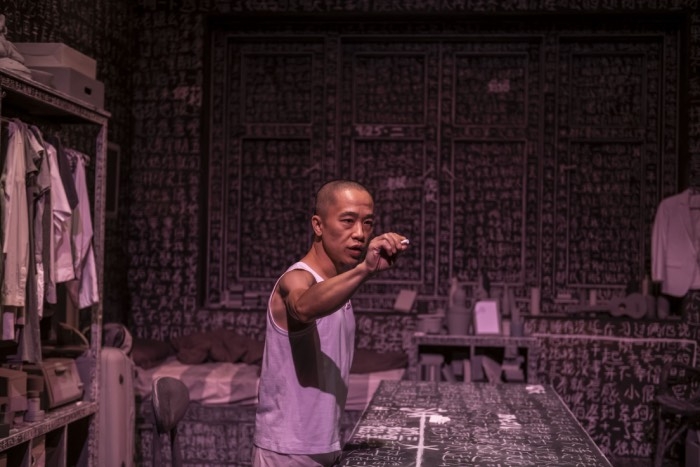By Victoria Chen
The grayscale set is simple and elaborate at the same time. Designed by Oliver Chong who also directs and acts in A Fiend’s Diary, it is completely embellished on every corner, surface and windowpane with words from the text written in white chalk. This might be the work of either a genius or a madman, but definitely of someone with too much time on their hands—the unnamed protagonist. He lies on a single bed under the duvet, eyes closed, as the audience enters.
Eventually he rises, his skin stretching, almost straining as he breathes deeply, as he observes his space and turns his neck, as if his physical being is in itself a kind of prison trapping the mind and soul within. He sits at the table, takes a piece of chalk, and traces a date that he has already written. Before a single word is uttered, it is already clear that no person is more fitting for this role than Chong himself.

Perhaps the previous comment is unnecessary. After all, Chong is the main creative voice behind the artistic process that drives this production, drawing heavily from personal life events. Adapted and inspired from 局外人 by 柳明九, A Fiend’s Diary depicts the absurdity of life and the futility in one’s search for its true meaning. The story begins with the protagonist’s mother’s passing, but through a series of perfectly reasonable actions that somehow come across as unusual to society, he starts being viewed as an outsider, and his refusal to conform eventually contributes to his death sentence after he commits a crime with no intention.

Nothing moves in this show except for the actor, who sits on a chair, sometimes the bed, or the rocking chair. There is no set transformation, the lighting (Lim Woan Wen) is barely noticeable, and apart from the monotonous piano key pulsating throughout the show, there is little variation in the soundscape (Darren Ng).
Nothing changes in this show, and yet everything transforms. The devil is definitely in the details. Chong conjures various characters through a slight but distinct shift in vocal register and tonality, sometimes with gestures as well. At one point, he puts on a white tank top—normal enough, until one realises that the seams are slightly misaligned. Thanks to Lim, at times the set glows amber, at times the lights dim—the change is subtle and yet adds character to the space, as if it is active in caging the character within its walls. Ng’s single piano note is like a dull pain in the head, its unrelenting monotony pressing into your temples to the point that one feels release—(relief)—when the gunshots pierce through the air.
Despite being the storyteller, Chong’s main character is detached, speaking evenly, recounting events sterilely—in any other situation, a person like this would bore its listeners. However, the audience remains engaged. Chong is compelling and the story is effectively conveyed, and it is definitely due to evocative lighting and sound combined with Max Tan’s costume design that supports the actor’s masterful performance.

The latter section of the performance is easier to follow than the former. It breaks from the protagonist’s mundane routine and features quicker shifts in characters and dialogue. Instead of painfully precise description of the smallest occurrences, the plot moves along, and it is apparent how every stringent detail in the first section has been relevant after all. What the protagonist sees as logical and reasonable is viewed with outrage by the rest of society, and the audience sits helplessly and passively, witnessing how quickly and easily it is for someone who deviates from the norm can be so easily crucified for just being.
We are both the outsiders and the adjudicators of what is considered acceptable or not. Why do these rules exist, and why must they be followed? Why do we set the rules only to be restrained by them? Life is meaningless, merciless and absurd. Perhaps it all comes down to the meaning one makes of one’s suffering.
Photography credits: Tuckys Photography
A Fiend’s Diary by The Finger Players runs till 27 October 2019.
==
Stay updated and social with Popspoken: Telegram| Facebook | Twitter | Instagram







